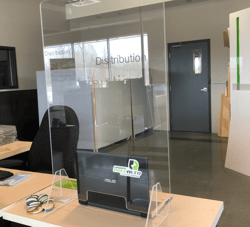COVID-19 has changed the way we produce and consume goods and services. Indeed, traditional production methods have been upended. To continue their operations, businesses have been forced to adapt to this new reality. Although businesses understandably wish to carry on with their operations, personnel safety must be a priority. Fortunately, it is possible to reduce risks by implementing strict measures as quickly as possible and by ensuring that each employee follows the rules. Clear and effective communication is also vital to mitigate risks. This must be a collective effort: employees who do not comply with these measures may compromise the safety of the entire business. The success of theses measures largely depends on effective communication and the full cooperation of employees.
Two solutions to safeguard your facilities
1. Restrict workspaces
Employees must maintain a distance of 2 metres between each other at all times. However, there may be circumstances where practising social distancing is difficult or almost impossible. These situations can represent a logistical challenge, notably because certain workstations, machines and devices cannot easily be moved. Social distancing can also pose a challenge in common areas, such as cafeterias, locker rooms and restrooms. Here are some concrete solutions that are easy to implement:
Cafeterias: multiple free-standing partitions made from acrylic or polycarbonate can be used to limit contact between employees without isolating them. This way, they can have lunch together while being protected by a clear shield.
Workstations: free-standing protection shields made from acrylic or polycarbonate can be used to avoid relocating employees or having to review your office layout.
Reception desks and customer reception desks: installing protection shields is a great solution to reduce the risk of contamination.
Businesses which have an office area and a production area might choose to keep employees separate by establishing spaces that are only accessible to factory workers and others reserved for office workers. If possible, the ideal solution would be to control access to certain areas by ensuring that factory workers have a separate entrance. This avoids contact between workers and prevents office employees from contaminating factory employees and vice versa.


 Businesses which have an office area and a production area might choose to keep employees separate by establishing spaces that are only accessible to factory workers and others reserved for office workers. If possible, the ideal solution would be to control access to certain areas by ensuring that factory workers have a separate entrance. This avoids contact between workers and prevents office employees from contaminating factory employees and vice versa.
Businesses which have an office area and a production area might choose to keep employees separate by establishing spaces that are only accessible to factory workers and others reserved for office workers. If possible, the ideal solution would be to control access to certain areas by ensuring that factory workers have a separate entrance. This avoids contact between workers and prevents office employees from contaminating factory employees and vice versa.
2.Establish checkpoints
Set up checkpoints or “decontamination” stations at every entrance and provide specific steps to follow. To build temporary stations, free-standing partitions made from double-wall polycarbonate or double-wall acrylic can be installed. When arriving at a station, each employee will have to:
- clean their hands using hydroalcoholic gel
- clean their belongings (keys and cellphone) with disinfecting wipes.
- clean the sole of their shoes.
If you wish to implement further preventive measures, it may be appropriate to take the temperature of each employee to ensure they do not have a fever, in which case they have to return home. Of course, these steps are mere suggestions, as we are in no way experts in the medical field.
General recommendations:
1. Wear a mask or a face shield
Wearing a mask or a face shield is an easy way to limit the risk of contagion in areas where several people work in close quarters. The Public Health Agency of Canada now recommends wearing a mask in situations where it is impossible to maintain a physical distance of 2 metres. Wearing a mask also limits the risk of contagion if a person is infected but asymptomatic. The purpose of wearing a mask or a face shield is to prevent those who are wearing it from contaminating their colleagues. Although this is an excellent preventive measure, it is important not to take it for granted, as wearing a mask or a face shield does not completely protect people from infection. Risks are always present, and everyone must therefore remain vigilant.
2.Opt for virtual meetings
Easily limit contact between employees by replacing traditional in-person meetings with videoconferences. In cases where videoconferencing is not possible, phone calls are a good option. After all, less contact reduces the risk of contamination.
3.Stagger work schedules
Another effective way to limit contact between employees is to stagger work schedules. However, this measure remains specific to each business based on their opening hours and available resources. The objective is to limit coactivity. This measure:
-
limits the number of people present in the same place at the same time. Consequently, this reduces the risks of contamination for all employees. Since fewer employees are present, it also facilitates compliance with social distancing rules.
-
limits the spread of the virus if one or more employees test positive to COVID-19. Since only one group needs to be quarantined, it therefore maximizes the chances of remaining operational by preventing worst-case scenarios.
Factory safety indisputably involves many factors. The measures suggested above are relevant during a pandemic, but multiple other factors must be considered to ensure that a work environment is as safe as possible. These include:
- choosing the right materials for your structures
- preventing falls and workplace injuries
- safeguarding machinery










